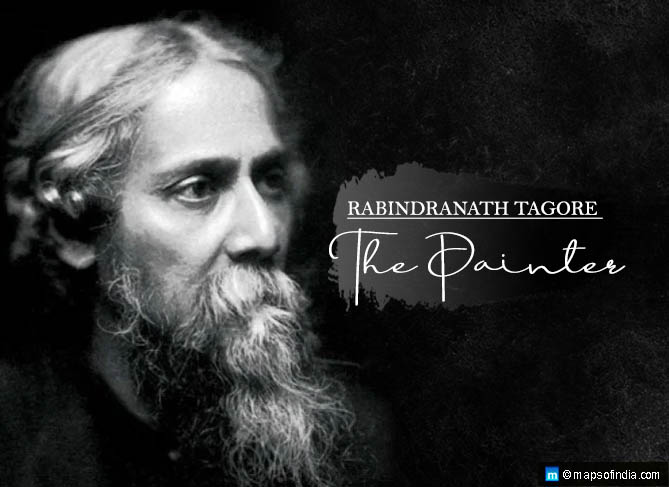The name Rabindranath Tagore is synonymous with great poetry, novel writing, music and finally with great painting. However, the story of Tagore the painter, follows a different trajectory than the Writer-Tagore’s, for instance.
Though always surrounded by painters and always nurturing the desire to paint, unlike his other talents, painting did not come easily to Tagore. The young Rabindranath had given up hopes of becoming a painter. However, he still continued to doodle in his manuscripts. A struck out word became an artistic letter, and an art-nouveau-like pattern ensued in his writings. (Scholars today see his manuscripts themselves as works done by a creative genius.) This took shape until 1923. The following year, however, there was a burst of doodles in his manuscripts. These doodles became more representational by and by.
While the earlier doodles were subconscious transformations of letters variously to bizarre masks, fantastical beasts, birds and flowers, etc. mystic landscapes and dramatic paintings soon ensued.
Driven by success, the 67-year-old Tagore, did his first independent painting in 1928. More such followed. These were later exhibited first in Paris (on the insistence of friends he met on tour in southern France) and later in the rest of Europe, Russia, England and America. He was the first such artist from India to be exhibited so widely.
As far as his medium was concerned, Tagore dabbled variously in ink, crayon, pastel, watercolour, and even used his fingers for effect – a sure sign of a creative and imaginative technique. There is a vitality associated with his work, especially as it took a more concretised form over time. In this sense, his paintings can be, like his writings and poetry, considered very Indian and modernist at the same time.
As for the reception of his paintings – much like his other pursuits – the Western world was appreciative and awed by his work. For them, however, the work Tagore exhibited was no different than that of a Picasso or a Manet. His work was seen as an extension of Western artistic tradition. The Indian context, by and large, remained ignored.
All this changed in the 1940s. Where Tagore’s true place as an Indian artist came to be recognised. That it came with Indian Independence is no coincidence. As India found its place in the world, Tagore found his in the realm of art.
The Indian Ministry of Culture had commissioned an exhibition of over 200 paintings of Tagore and called it The Last Harvest. A lot of his doodles today find their way into public places: the walls of the Rabindra Sadan Metro Station in Kolkata, for instance.
Looking at his paintings today, scholars try to find a pattern, a unifying theme, or a grand universalist design in them. But this is only speculation. Tagore’s works can perhaps be best described in his own words:
“But one thing which is common to all arts is the principle of rhythm which transforms inert materials into living creations. My instinct for it and my training in its use led me to know that lines and colours in the art are no carriers of information; they seek their rhythmic incarnation in pictures. Their ultimate purpose is not to illustrate or to copy some outer fact or inner vision, but to evolve a harmonious wholeness which finds its passage through our eyesight into imagination. It neither questions our mind for meaning nor burdens it with bleakness, for it is, above all, meaning.‟





